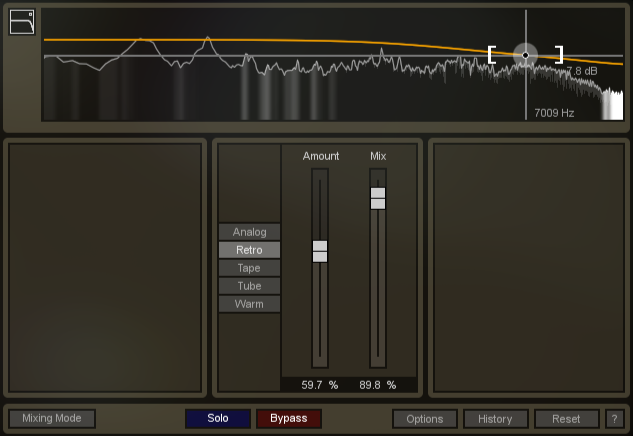
Nectar’s Saturation module can infuse your vocals with the subtle effects of tube, tape and other analog hardware by emphasizing even and odd harmonics in varying amounts.

Amount
Controls the drive of the selected harmonic-generating saturation mode.
Mix
Allows you to control the mix of the saturated (wet) signal with the original (dry) signal.
Tape
Tape mode emphasizes odd harmonics but with a shorter harmonic slope than a transistor, and emulates the sound of analog tape when pushed to saturation.
Tube
Tube mode emulates the sound of tube saturation with a mix of even and odd harmonics. It is characterized by its clear "tonal" excitation.
Warm
The Warm mode generates only even harmonics with a steep slope and, as such, may be used as a subtle warming effect.
Analog
The Analog mode emulates the sound of transistor type odd harmonics giving a driven grit to your audio.
Retro
This algorithm is based on a row of odd harmonics characteristic of transistors resulting in a sharp, somewhat aggressive sound.

 When saturating your vocals, often times the added harmonic content can make the sibilant frequencies in a vocal take harsh or biting. Click and drag on the high-shelf filter node in order to reduce the gain of these high frequencies.
When saturating your vocals, often times the added harmonic content can make the sibilant frequencies in a vocal take harsh or biting. Click and drag on the high-shelf filter node in order to reduce the gain of these high frequencies.
The high-shelf filter will only reduce the high frequencies present in the saturated (wet) signal. Different saturation algorithms such as the Tube and Warm modes, rely on a strong dry signal in order to perform their saturation. As such, the high-shelf filter will have varying amounts of perceived effect on your vocals depending on the algorithm chosen.
Mini-spectrum Display
 Each module of Nectar features a display of the frequency spectrum at the top for reference while making changes to your audio within the module. The Saturation module’s Mini-spectrum Display also features a high-shelf post-filter which filters only the wet (saturated) signal.
Each module of Nectar features a display of the frequency spectrum at the top for reference while making changes to your audio within the module. The Saturation module’s Mini-spectrum Display also features a high-shelf post-filter which filters only the wet (saturated) signal.
Harmonic Highlights
The Saturation module’s Mini-spectrum display additionally features highlights to pinpoint where harmonics are being added to your signal. Brighter white highlights indicate more prominent added harmonics at that frequency.